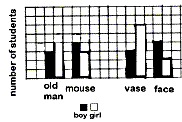BACKGROUND:
Optical illusions are
caused when shapes and light interact with our sense of sight and
make our brain interpret objects that may not be there. There are
different types of optical illusions from camouflage to mirages.
Camouflage refers to when objects, either two-dimensional or three-dimensional,
blend into one another. Warriors and hunters have used this illusion
to hide from their enemy or catch their prey. A mirage is when
a deceptive appearance of objects is caused by refraction (bending of light)
in layers of air of varying densities. Many magicians use this principle
to help deceive our eyes.
Students will be looking at
a visual illusion caused by geometric placement where shading, shape, and
color confuse our sense of sight into seeing something two different ways
from the same picture. Sometimes you train your eyes to look one
way and you see one object, and then look another way and see another object.
PROCEDURE:
- Experiments
conducted by scientists are usually designed before data is collected.
Data can be collected on just about anything as long as the data can be
compared and contrasted. Ask students how they would design an experiment
using optical illusions.
- Explain that an optical
illusion appears to be something that it isn't. That sounds "qualitative,"
or a least subjective. How can it be made quantitative? Compare
girls and boys reactions and see if there is a pattern. Ask students
if there is any other way. If they don't come up with a better experiment,
use the suggestion below.
- Show the optical illusions
to the class of the mouse/man and vase/2 faces, and have them write
down what they see.
- Review what they saw
and point out the possibilities of each picture. Record the data
on the board. Subdivide their answers into girls and boys.
- After going through
the pictures, see if students' results can be made quantitative by putting
numbers on the data. You can quantitate the results by collecting
data that looks at groups of people by sex (in this case). Have students
construct a bar graph. Collect the data from the class using
the following format. Students will have to think how to construct
such a graph because it has more variables than the previous exercise.
| |
BOYS
|
GIRLS
|
| mouse |
|
|
| old man |
|
|
| vase |
|
|
| 2 faces |
|
|
-
Below is a possible way in which
students can graph the data. Notice this type of bar graph compares boys and
girls. Discuss with students if you can interpret the data using the graph
generated.

|